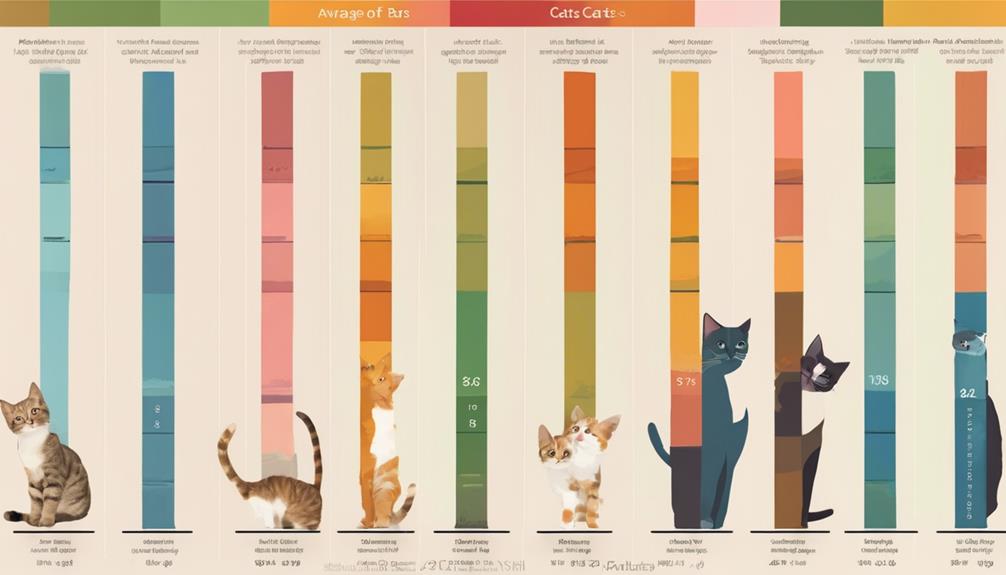Cats cannot drink coffee safely. Even a small amount is highly toxic to them, leading to severe health risks and potential poisoning. Symptoms of caffeine toxicity in cats include hyperactivity and increased heart rate. Immediate veterinary care is essential if ingestion occurs. Prevent access to coffee and opt for safe alternatives like fresh water or cat-friendly milk. Cats' lower tolerance for caffeine makes them vulnerable to toxicity. Factors like breed and health impact cats' response to caffeine. Understanding the risks can help safeguard your feline friend's well-being. Additionally, considering decaffeinated options and sugars' impact on cats' health is crucial.
Key Takeaways
- Cats should never drink coffee due to extreme sensitivity to caffeine.
- Even small amounts of coffee can lead to poisoning in cats.
- Symptoms of caffeine poisoning in cats include hyperactivity and increased heart rate.
- Immediate veterinary care is necessary for distressed cats.
- Prevention is crucial: keep coffee away from cats to safeguard their health.
Risks of Cats Drinking Coffee
Drinking coffee poses serious risks to cats due to the toxic effects of caffeine. Cats are highly sensitive to caffeine, and even a small amount can lead to poisoning, causing a range of health issues.
The ASPCA strongly advises against giving coffee to pets, emphasizing the dangers associated with the toxic methylxanthines found in this popular beverage. If a cat ingests coffee accidentally, it can result in caffeine poisoning, manifesting as hyperexcitability, vomiting, and an increased heart rate.
These symptoms can escalate to more severe complications like heart problems and seizures, highlighting the critical need to keep coffee and other caffeine-containing products away from our feline companions. Remember, what might seem like a harmless treat to us can have detrimental effects on our beloved cats.
Being mindful of their unique physiology and vulnerabilities is vital in ensuring their well-being and longevity.
Caffeine Sensitivity in Cats

Cats have a lower tolerance for caffeine compared to humans, which means even small amounts can pose potential health risks.
It's important to be cautious with coffee, tea, or soda around cats, as even a few licks can be harmful.
To keep our feline friends safe, it's best to explore safe alternatives and prevent access to coffee or other caffeinated drinks.
Cat Caffeine Tolerance
Although humans may enjoy their morning cup of coffee, cats have an extreme sensitivity to caffeine, making it important to keep all caffeinated products away from them.
Cats' caffeine sensitivity can lead to severe health issues, including caffeine toxicity, even with small amounts. Due to their low tolerance and inefficient caffeine metabolism, cats can quickly show symptoms like hyperactivity, restlessness, and increased heart rate when exposed to caffeine.
It's essential to understand that what may seem harmless to us can pose a significant risk to our feline friends. Keeping coffee and other caffeinated products out of reach of cats is a simple yet crucial way to secure their well-being and prevent any potential harm.
Potential Health Risks
Given their heightened sensitivity to caffeine, it's important to understand the potential health risks that cats face when exposed to even small amounts of coffee. Cats can experience caffeine poisoning, which can manifest in symptoms like increased heart rate, restlessness, and even seizures.
Just one or two licks of coffee can be harmful to our feline friends due to their low tolerance for caffeine. Unused coffee grounds, beans, or tea bags pose an even higher risk of severe toxicity in cats. It's crucial to keep coffee and related products out of reach to prevent accidental ingestion.
Cats may be drawn to coffee due to the milk or cream content, so extra caution is necessary to safeguard their health. Let's prioritize our cats' well-being by keeping them away from coffee to safeguard they stay healthy and happy.
Safe Alternatives for Cats
To guarantee our feline companions' well-being and health, it's vital to explore safe alternatives for them considering their sensitivity to caffeine. When it comes to keeping our cats hydrated and happy, we can opt for the following safe alternatives:
- Fresh Water: Providing clean, fresh water is essential to make sure proper hydration for our cats without any risks associated with caffeine.
- Cat-Friendly Milk: Opt for specially formulated cat milk that's safe for feline consumption and can be a tasty alternative to caffeinated beverages.
- Specialized Cat Treats: Treats designed specifically for cats can be a great way to reward them without exposing them to the dangers of caffeine sensitivity.
Symptoms of Caffeine Toxicity

Cats can exhibit various symptoms of caffeine toxicity, such as increased heart rate, restlessness, and seizures. These signs may also include vomiting, diarrhea, agitation, and rapid breathing.
Monitoring for these effects and seeking prompt veterinary care is essential for the well-being of our feline companions.
Caffeine Poisoning Signs
Recognizing the symptoms of caffeine poisoning in cats promptly is vital for ensuring timely veterinary care. When it comes to signs of caffeine poisoning in your feline friend, keep an eye out for the following:
- Increased heart rate and hyperactivity can signal a potential issue.
- Vomiting, diarrhea, and tremors may indicate caffeine toxicity in cats.
- Agitation and seizures are serious symptoms that require immediate attention.
Being vigilant as pet owners can help prevent the dangers associated with caffeine ingestion. If you notice any of these symptoms, it's essential to seek veterinary care promptly to guarantee the well-being of your beloved cat.
Effects on Feline Health
Indications of caffeine toxicity in felines encompass a range of symptoms that warrant immediate attention from veterinary professionals. Symptoms such as hyperexcitability, vomiting, increased heart rate, seizures, and, in severe cases, even death can occur due to caffeine ingestion. Different coffee types have varying caffeine levels, influencing the risk of toxicity in cats.
The effects of caffeine ingestion in cats can manifest within hours of exposure. If a cat shows signs of caffeine poisoning, prompt veterinary care is essential. Treatment may involve induced vomiting, administration of intravenous fluids, medications, or hospitalization.
While cats are less prone to caffeine toxicity than dogs, any suspicion of ingestion should be taken seriously to guarantee the well-being of our feline companions.
Immediate Actions After Coffee Ingestion

Upon noticing that a cat has ingested coffee, swift action is important to prevent further harm and monitor for potential signs of caffeine toxicity. Here are the immediate actions to take:
- Remove the cat from the coffee area: This prevents additional consumption and reduces the risk of further poisoning.
- Monitor closely for signs of distress: Pay attention to any unusual behavior within the next 30-60 minutes. Look out for symptoms like restlessness or increased heart rate.
- Contact a veterinarian promptly: If you notice any signs of caffeine poisoning, such as vomiting, tremors, or seizures, it's essential to seek professional help immediately. Don't attempt to treat the cat on your own as vet intervention is necessary for proper care.
Importance of Seeking Veterinary Help
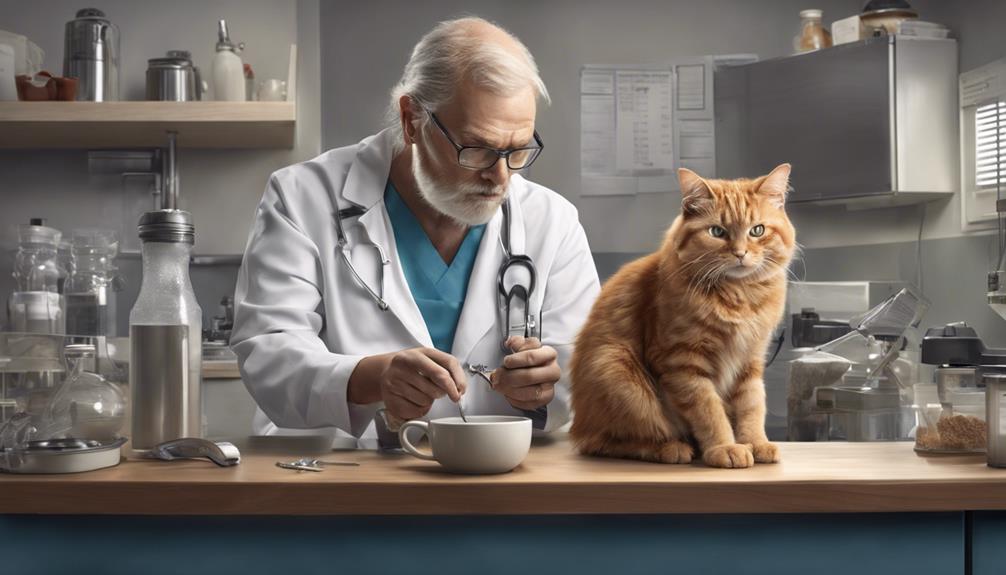
Seeking prompt veterinary assistance is vital if a cat displays symptoms of caffeine poisoning after consuming coffee. When it comes to our feline friends, acting quickly can make a significant difference in their recovery. Veterinarians are equipped to provide the necessary care, such as inducing vomiting, administering fluids, or offering medications to counteract caffeine toxicity.
Monitoring the cat closely post-ingestion and following professional guidance are essential steps in ensuring a positive outcome. Delaying veterinary help can worsen the cat's condition and lead to severe health issues.
Preventing Future Incidents
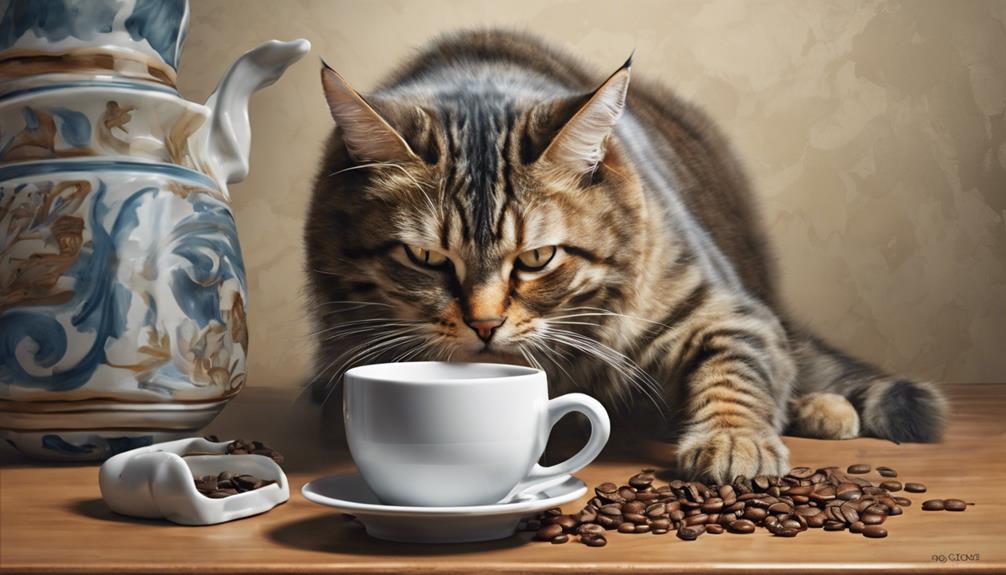
After addressing the importance of seeking veterinary help for cats who've ingested coffee, the focus now shifts to preventing future incidents to safeguard our feline companions' well-being. Here are three essential steps to guarantee our cats stay safe:
- Store coffee securely: Keep coffee in a place that's inaccessible to cats. Consider using sealed containers or cabinets to store coffee grounds, beans, or brewed coffee safely away from curious paws.
- Educate household members: It's vital to inform everyone in the household about the hazards of coffee for cats. By raising awareness, we can all work together to create a safe environment for our furry friends.
- Discourage cat access: Take preventive measures such as not leaving coffee cups unattended and using deterrents like bitter apple spray on coffee-related items. These actions can help deter cats from trying to access coffee, reducing the risk of accidental ingestion.
Let's collaborate to keep our cats safe and healthy!
Coffee Consumption Effects on Cats

Discussing the effects of coffee consumption on cats reveals the potential risks associated with caffeine exposure for our feline companions. Caffeine, present in coffee, can have significant impacts on cats, affecting their heart rate, need to urinate, and sensory stimulation due to the caffeine and theobromine content. Symptoms of caffeine ingestion in cats may manifest as restlessness, hyperactivity, and could rapidly escalate depending on individual health factors.
Ground coffee is particularly hazardous for cats because of its high toxicity level from caffeine content. Ingesting caffeine can result in severe internal issues and, in extreme cases, even death for our beloved pets. Being mindful of these effects is essential in safeguarding our feline friends from the dangers of coffee consumption.
Vets Approach to Coffee Ingestion
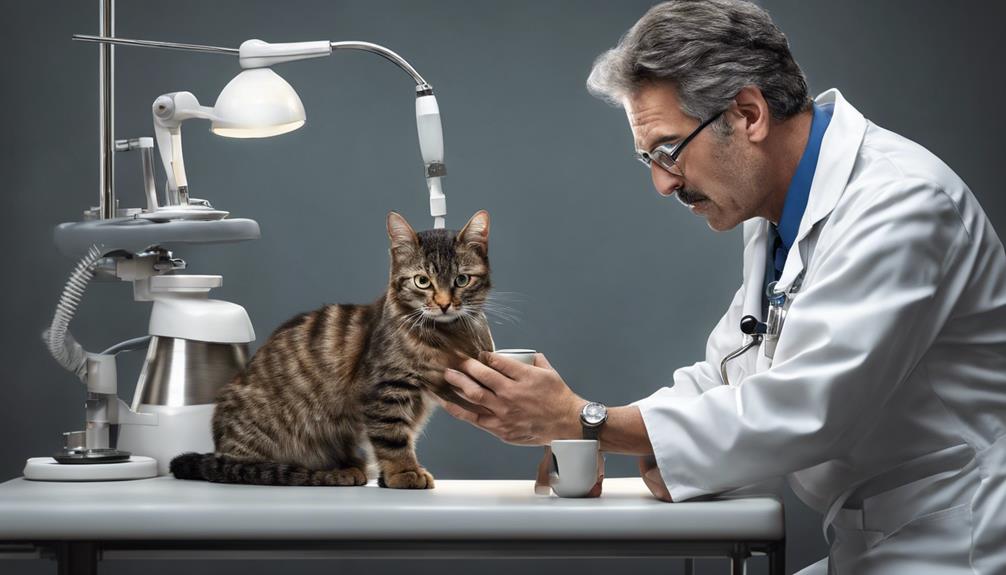
When addressing coffee ingestion in cats, veterinarians emphasize the importance of immediate action to prevent caffeine poisoning. Here's how vets approach coffee ingestion in felines:
- Quick Response: Time is essential in preventing caffeine poisoning. Vets recommend acting promptly to minimize the risks associated with coffee ingestion in cats.
- Symptom Monitoring: After coffee ingestion, monitoring the cat for symptoms of caffeine poisoning is crucial. Any signs of distress should prompt immediate veterinary care to guarantee the cat's well-being.
- Tailored Treatment: Treatment for caffeine poisoning may involve inducing vomiting and providing fluids. Vets assess the cat's health, the amount of coffee ingested, and the type of coffee consumed to determine the most effective course of action. Tailored veterinary care is necessary for a successful recovery from coffee exposure in cats.
Cats Recovery From Coffee Exposure

When it comes to cats recovering from coffee exposure, it's essential to take into account their caffeine sensitivity and the symptoms of coffee toxicity they may exhibit.
While most cats bounce back well from small coffee doses, severe cases might necessitate immediate veterinary attention.
Monitoring your feline friend closely post-exposure is key to catching any signs of distress early on.
Cats Caffeine Sensitivity
After coffee exposure, cats can recover with proper veterinary care and monitoring, depending on factors such as the amount consumed, the cat's health, and the type of coffee ingested. When dealing with cats' caffeine sensitivity, it's crucial to comprehend the effects of caffeine on their delicate systems.
Here are some key points to take into account:
- Caffeine sensitivity: Cats can be more sensitive to caffeine than humans, making even small amounts harmful to their pets.
- Effects of caffeine: Caffeine can lead to a range of symptoms in cats, from mild agitation to severe toxicity.
- Harmful to their pets: Owners must be cautious as excessive caffeine can have detrimental effects on their beloved feline companions.
Understanding these factors can help safeguard the well-being of our furry friends.
Symptoms of Coffee Toxicity
Considering the potential symptoms of coffee toxicity in cats, it's important to recognize the signs that indicate recovery from coffee exposure.
After ingesting coffee, cats may exhibit hyperactivity, restlessness, vomiting, and an increased heart rate. These symptoms signal the need for immediate attention and monitoring. If your feline friend shows distress or behaves abnormally after coffee consumption, it's vital to seek veterinary care promptly.
Recovery from coffee exposure varies depending on the amount consumed and the type of coffee ingested. Close observation and appropriate treatment can aid in the cat's recovery process.
Coffees Lethal Potential for Cats

Cats face a significant risk of poisoning from coffee due to their sensitivity to caffeine, with even small amounts of espresso potentially leading to severe symptoms. When it comes to coffee's lethal potential for cats:
- Mild Signs from Ingesting Instant Coffee Grounds: Just 3 teaspoons of instant coffee grounds can set off mild symptoms in cats, indicating the potency of caffeine even in small doses.
- Severe Symptoms from Coffee Grounds: Ingesting 10 teaspoons of instant coffee grounds can escalate into severe symptoms for cats, underscoring the danger coffee poses to our feline friends.
- Espresso's High Caffeine Levels: Espresso, with its higher caffeine content, poses an increased risk to cats compared to regular coffee. This emphasizes the importance of keeping all forms of coffee away from cats to prevent accidental ingestion and subsequent harm.
Understanding the potential dangers of coffee for cats is vital for responsible pet ownership. Keeping these facts in mind is necessary to safeguard the safety and well-being of our beloved feline companions.
Coffee Grounds and Cat Safety

When handling coffee grounds around feline companions, vigilance is crucial to prevent accidental ingestion and potential harm. Cats are naturally curious creatures and may be attracted to the strong scent and texture of coffee grounds. However, it's essential to keep these grounds out of reach, as even a small amount ingested can lead to severe toxicity due to their concentrated caffeine content. Compared to brewed coffee, coffee grounds pose a higher risk of poisoning in cats.
| Risk of Coffee Grounds | Effects on Cats | Action to Take |
|---|---|---|
| High | Adverse effects | Contact pet poison helpline |
If you suspect your cat has ingested coffee grounds, immediate veterinary attention is essential to prevent severe health complications. Remember, prevention is key when it comes to keeping our feline friends safe from potential dangers like coffee grounds.
Decaffeinated Coffee Considerations
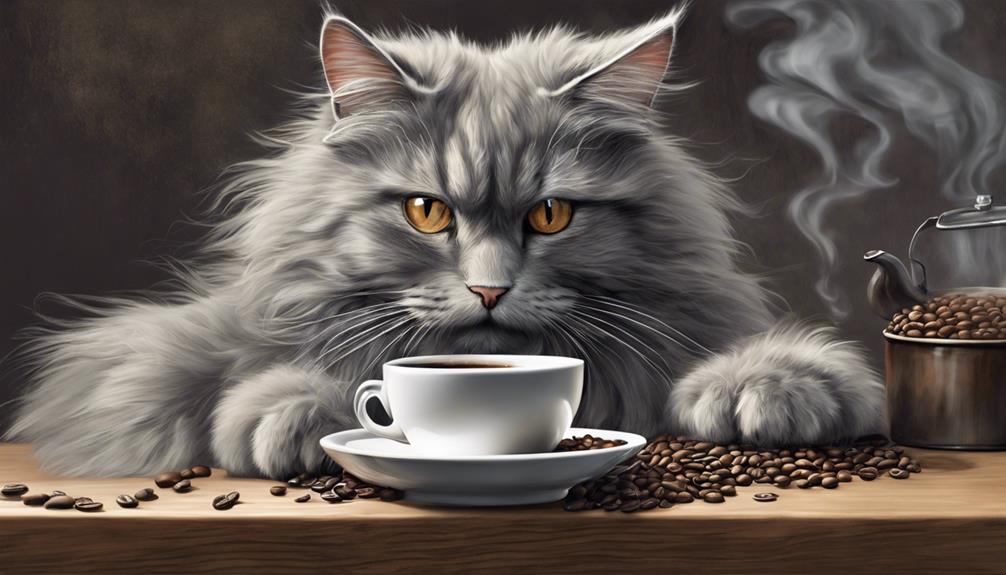
After consuming decaffeinated coffee, cats may still experience mild toxicity due to the remaining caffeine content present in the beverage. It's crucial to be cautious and avoid exposing your feline friends to decaffeinated coffee due to the potential health risks associated with its caffeine content.
- Even small amounts of decaffeinated coffee can lead to symptoms of caffeine poisoning in cats, putting their health at risk.
- Decaffeinated coffee still contains some caffeine, albeit in lower amounts compared to regular coffee, which can cause mild upsets in cats.
- It is advisable to steer clear of giving any type of coffee, including decaffeinated, to cats to prevent any adverse effects on their well-being.
Sugars Impact on Cats and Coffee
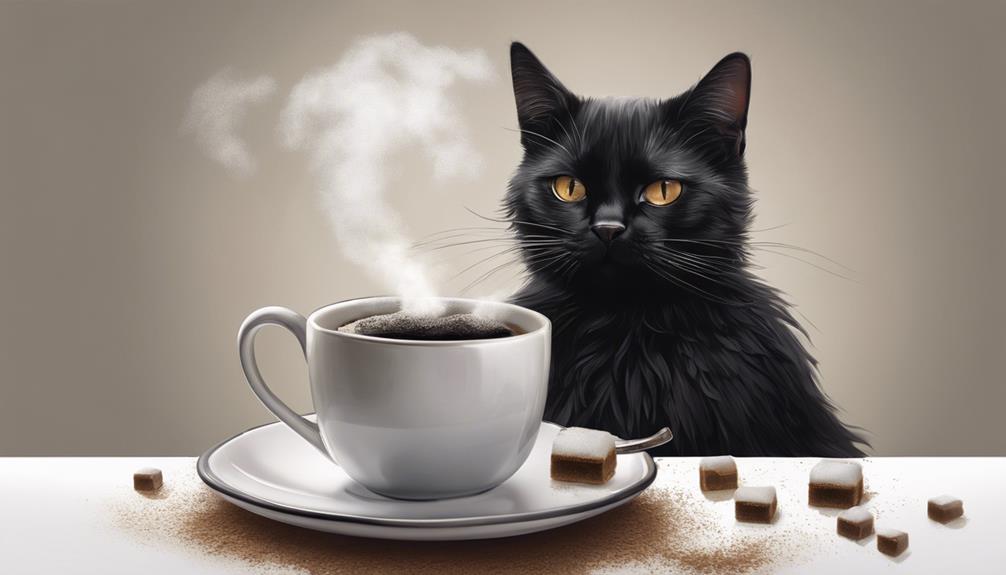
When it comes to cats and coffee, the impact of sugars is significant. Excessive sugar in coffee can lead to weight gain, dental problems, and digestive issues in our feline friends.
Be mindful of the risks associated with sugar consumption for cats when considering sharing your coffee with them.
Sugar and Cat Health
Sugar in coffee poses potential risks to the health of cats, including weight gain, diabetes, and dental issues. Cats aren't naturally drawn to sugary flavors, and their bodies aren't equipped to process high levels of sugar. Here are three ways sugar can impact your feline friend's health:
- Weight Gain: Excessive sugar consumption can lead to unhealthy weight gain in cats, putting strain on their joints and organs.
- Diabetes: A diet high in sugar can disrupt a cat's metabolism, increasing the risk of developing diabetes over time.
- Dental Issues: Sugary substances like coffee can contribute to dental problems in cats, such as tooth decay and gum disease.
To keep your cat healthy and happy, it's best to avoid giving them sugary treats like coffee.
Caffeine Sensitivity in Cats
Cats' sensitivity to caffeine makes it important to be cautious about their exposure to coffee and related products, considering the potential risks to their health. Unlike humans, cats lack the necessary enzymes to efficiently process caffeine, making even small amounts harmful to their nervous system. The effects of caffeine on cats can lead to serious health issues, affecting their heart and overall well-being.
Additionally, the sugar content in coffee can also pose dangers to cats, exacerbating the potential harm. To safeguard our feline friends, it's essential to keep all caffeinated products, including coffee, out of their reach. By being mindful of their sensitivity to caffeine, we can help guarantee our cats lead healthy and happy lives free from unnecessary risks.
Risks of Coffee
As pet owners, we must be diligent about the risks associated with coffee consumption for our furry companions. When it comes to cats and coffee, there are several reasons why it's harmful:
- Caffeine Content: Coffee contains caffeine, which can have serious effects on cats' health, including heart problems and seizures.
- Harmful Additives: Coffee often contains harmful levels of milk and sugar, which lack nutritional value and can be detrimental to cats.
- Toxicity Concerns: The ASPCA warns against giving coffee to pets due to toxic methylxanthines present in coffee, which can be harmful to cats.
It's important to keep coffee and other caffeinated products away from our feline friends to safeguard their well-being.
Caffeine Poisoning Signs in Cats
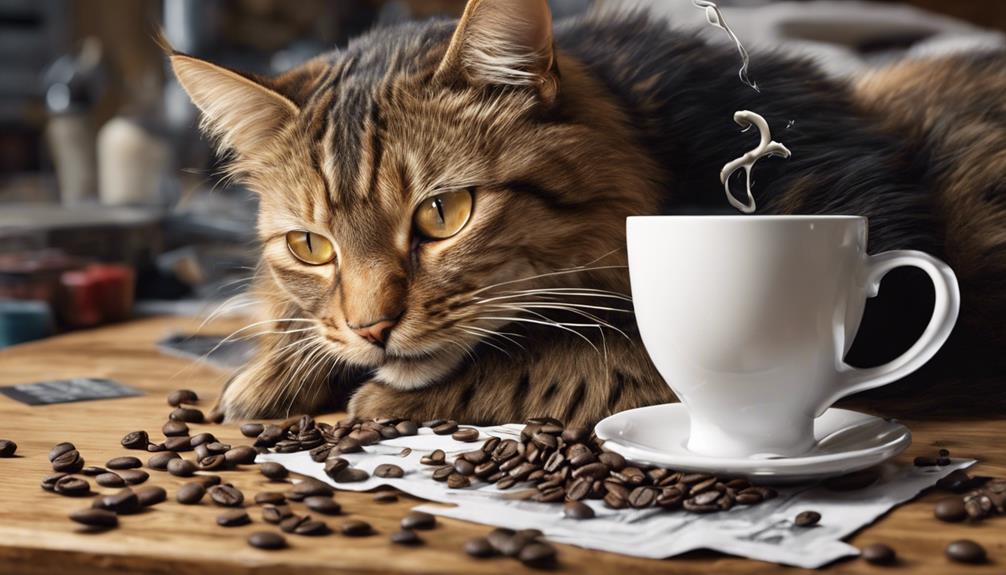
Detecting caffeine poisoning signs in cats early is vital for their prompt treatment and positive prognosis. If your feline friend has ingested toxic levels of caffeine, watch out for increased heart rate, restlessness, and hyperactivity as initial signs.
Vomiting, tremors, and seizures may also occur, indicating a serious situation that necessitates immediate veterinary attention. Monitoring for symptoms like agitation, rapid breathing, and twitching can help identify toxicity early on.
Remember, recognizing these signs promptly can greatly impact your cat's treatment outcome. It's essential to act swiftly and seek professional help if you suspect caffeine poisoning in your beloved pet. By staying vigilant and informed about these warning signs, you can safeguard the well-being and health of your furry companion.
Your quick response can make a significant impact in your cat's recovery from caffeine poisoning.
Factors Influencing Cats Caffeine Response

What factors influence how cats respond to caffeine ingestion?
Cats' bodies react differently based on various factors such as caffeine levels, breed predispositions, and overall health condition.
- Caffeine Levels: Cats' bodies can be sensitive to even small amounts of caffeine, especially those with underlying health issues. High caffeine content can quickly lead to severe reactions in cats with heart problems or lactose intolerance.
- Breeds: Certain breeds like Siamese, Himalayan, Siberian, Bengal, and Ragdoll are known to be more curious and likely to explore coffee. Their inquisitive nature may increase the chances of caffeine ingestion.
- Health Condition: Monitoring caffeine intake becomes essential, as it can greatly impact cats' well-being. Understanding the amount ingested and the type of caffeine consumed is vital for the safety of your feline companion. Factors like breed, health condition, and the specific caffeine type play significant roles in determining how a cat will respond to caffeine ingestion.
Frequently Asked Questions
What Happens if a Cat Drinks Coffee?
If a cat drinks coffee, it can experience severe symptoms like hyperexcitability, vomiting, rapid heart rate, and seizures. Various coffee types have different caffeine levels, impacting the toxicity risk. Immediate effects appear within hours, necessitating vet care.
Can Cats Have a Little Bit of Coffee?
We absolutely should not give cats any coffee. Even a small amount can be harmful due to the caffeine content. It's important to prioritize our feline friends' health and avoid any risks associated with coffee consumption.
How Much Coffee Is Safe for Cats?
Drinking coffee is unsafe for cats. Even a small amount can be harmful due to their sensitivity to caffeine. If a cat consumes coffee, immediate veterinary care is crucial to prevent serious health issues.
Why Does My Cat Want to Drink My Coffee?
Yearning for your coffee, feline friends may be fascinated by the fragrance, warmth, or milk it holds. However, it's unsafe for them. We must deter this behavior and offer them fresh water instead.
Conclusion
To sum up, while cats may be curious about coffee, it's best to keep this beverage out of their reach. Caffeine can pose serious risks to our feline friends, leading to symptoms of toxicity and potential poisoning.
Remember, prevention is key to keeping your cat safe and healthy. So next time you reach for a cup of coffee, make sure to keep it away from your curious cat's paws!






